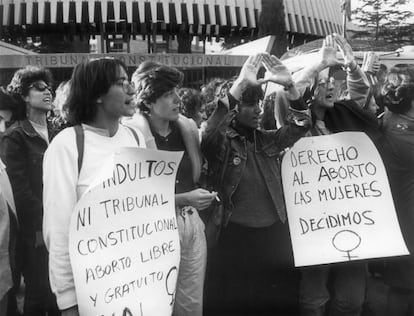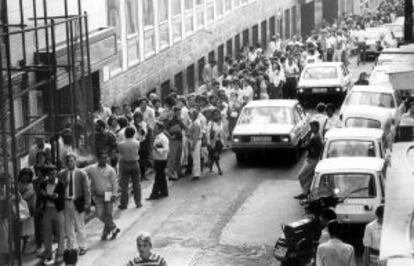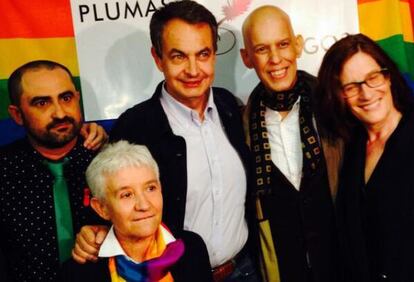Economic crisis denting Spaniards’ confidence in Europe, poll finds
Three decades after joining, Spanish support for the EU has slipped but remains high

Thirty years have passed since Spain joined what was then the European Community and is now the European Union, and Spaniards are not sorry that they did.
The country signed its adhesion treaty on June 12, 1985, integration took place on January 1, 1986, and it has consistently been one of the most enthusiastic members of the union ever since.
But a new poll shows that Spaniards’ enthusiasm for all things European has declined somewhat in recent years, and that the crisis is to blame.
Back in the 1980s, television was the most advanced technology most people had in their homes
A survey conducted this week by pollster Metroscopia shows that 70 percent of Spaniards feel European integration was good for Spain. Yet in May 2009, that figure was 80 percent.
But a majority of those surveyed valued Europe highly as a safe place that defends human rights, and expressed a desire for greater unity. Over 70 percent said the EU had managed to make armed conflict among its members “unthinkable.”
On the economic front, however, 37 percent of respondents said joining the EU was bad for the Spanish economy, compared with 54 percent who saw it as beneficial. But the relative recovery seen in recent months could push that figure upward in future polls.
The degree of skepticism varies according to respondents’ political beliefs. Supporters of emerging anti-austerity party Podemos expressed the most pessimistic views about the EU’s ability to pull Spain out of the crisis, while Popular Party voters were the most optimistic (77 percent), followed by supporters of Ciudadanos (67 percent) and the Socialist Party (57 percent).

Metroscopia president José Juan Toharia noted that around 74 percent of respondents, regardless of age or ideology, feel proud that Spain is a member of the EU.
“The emotional identification with the European project appears to successfully overcome the impact of seven years of social and economic hardship,” he said.
What’s more, 80 percent of those surveyed said they felt both Spanish and European. In 2011, that figure was no higher than 54 percent.
Much has changed since 1985, when then-prime minister Felipe González said Spain had the sentiment “of an old nation” and “the enthusiasm” of a new country.
The population back then was 38,473,418, compared with 47,691,772 today. Not quite 12 percent of that population was over 64, while today senior citizens represent over 18 percent of inhabitants. Birth rates have also declined sharply, from 11.95 per thousand to 9.1 per thousand in 2013, the last year that the National Statistics Institute (INE) has figures for.

Population shifts have turned Spain from a country of emigrants into one of immigrants. In 1986, foreign residents represented 0.63 percent of the population, while in 2014 they accounted for 10.7 percent. Only Germany, France and Britain have bigger migrant populations among EU members.
Some things, however, never change. Spain’s unemployment rate has always hovered above the European average over the last three decades, although it has fluctuated wildly.
In 1986 the jobless rate was 17.4 percent compared with the European average of 10.7 percent. There was near-convergence in 2005 when the rate hit nine percent, but after reaching its lowest mark in 2007, Spain’s unemployment rate soared again to 26.1 percent in 2012, more than twice the EU average.
Eighty percent of those surveyed said they felt both Spanish and European. In 2011, that figure was no higher than 54 percent
On the social front, when Spain joined the EU in June 1985 it was still treating abortion as a crime in all cases. A few weeks later, in July, pregnancy terminations were legalized in cases of rape, accredited fetal malformations and serious risk to the mother’s physical or mental health. In 2010, a Socialist government introduced abortion on demand in the first trimester, bringing Spain in line with other European nations. Later attempts by the conservatives to go back to a case-based system met with near-complete opposition.
Another major piece of social legislation to come into force during this time was the same-sex marriage law, which went into effect in July 2005. A total of 1,275 couples were married that year, representing 1.06 percent of all weddings. That number has risen to around 3,800 a year, over two percent of the total.
Yet another legal milestone was reached in 2006 when parliament passed a partial smoking ban in the country that back in 1985 had the highest proportion of smokers in Europe. The ban was expanded in 2011, eliminating the typical haze-filled interior of Spain’s bars, restaurants and other public venues.
At the educational level, Spanish students began taking advantage of the Erasmus exchange program (EuRopean Community Action Scheme for the Mobility of University Students) and gradually became more cosmopolitan, more familiar with other cultures, and better at foreign languages. The initial 95 students who enrolled in Erasmus in the academic year 1987/1988 had swelled to 39,249 participants by 2012/2013, according to the latest Education Ministry figures.
Meanwhile, the country was also busy with the technological transition. Back in the eighties, television was the most advanced technology most people had in their homes, and there were only two channels to watch, both operated by the state-owned Televisión Española. Today, there are also four private networks, several regional stations and dozens of international channels available to Spanish audiences. What’s more, by 2014, 74 percent of homes had an internet connection, according to INE figures.
In sports, back in 1985 the country’s soccer and basketball sides could only dream of the kinds of successes that have since come their way.







































